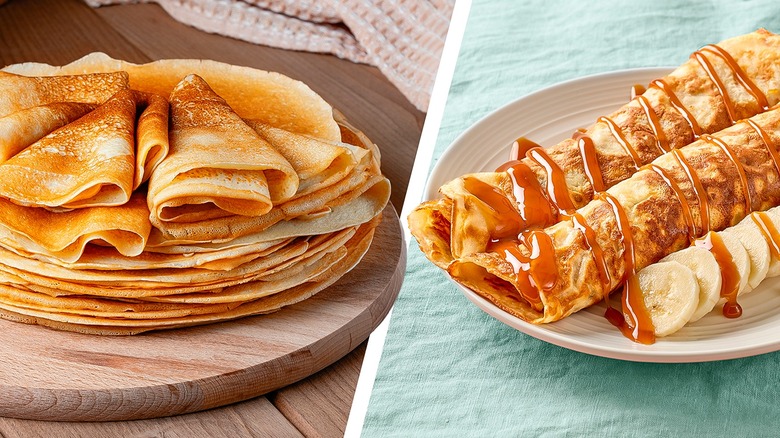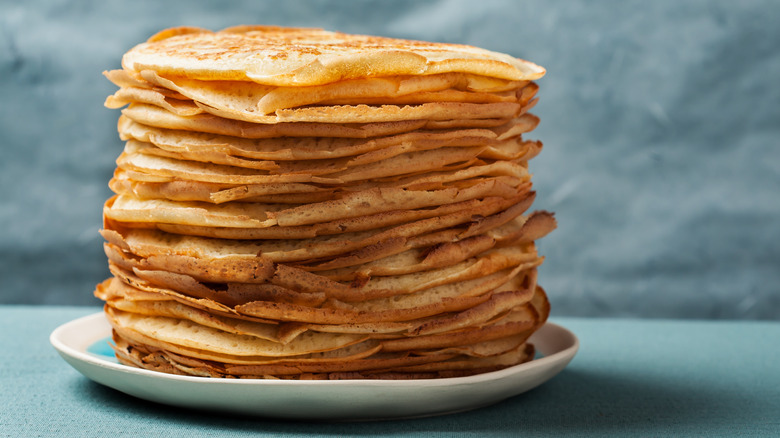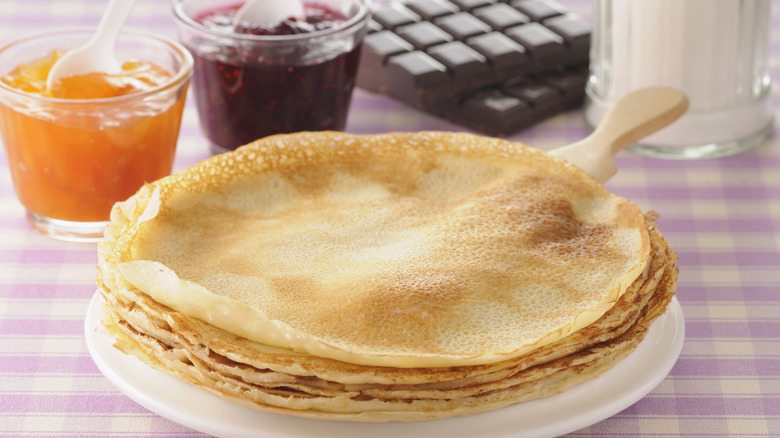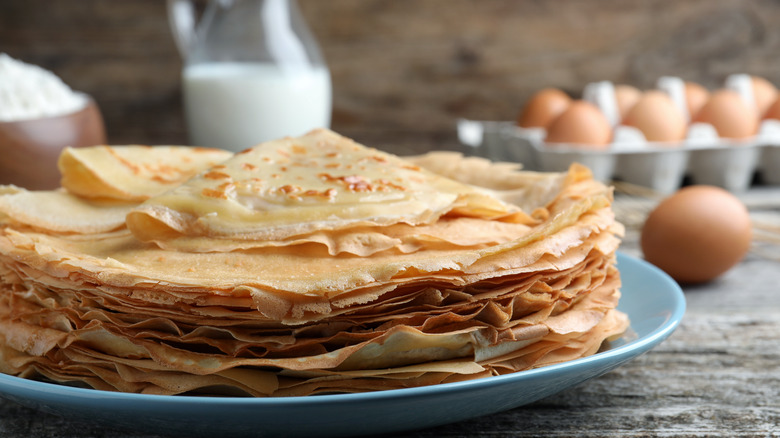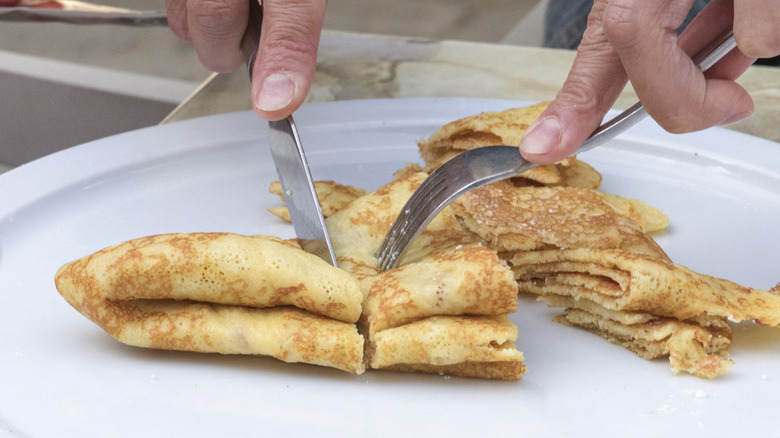Belgian Pancakes Vs Crepes: What's The Difference?
When it comes to breakfast and sweet treats, pancakes and crepes have secured their places as timeless favorites. American pancakes aside, Belgian pancakes are far more similar to crepes. In fact, you might have confused the two for being one and the same. You see, Belgian pancakes and crepes do share some qualities, but they are different in terms of both ingredients and culinary heritage, among other distinctive traits.
While one is relegated to only a sweet treat, the other can be enjoyed in more ways than one. Of course, differing ingredients also impact the texture and size of the thin, delicate treats. For example, one key ingredient that Belgian pancakes utilize is a leavening agent, which gives the thin pancakes slightly more thickness. However, this ingredient also causes Belgian pancakes to be smaller in diameter than crepes. With several additional key differences that set Belgian pancakes and crepes apart, let's uncover the origins, ingredients, textures, and delicious ways that each type of pancake is served up.
What are Belgian pancakes?
Belgian pancakes, known locally as "pannenkoeken", are a beloved treat hailing from the heart of Europe. These delectable delights have been a part of Belgian cuisine for centuries, showcasing the rich history and culinary traditions of the region. Belgian pancakes were prepared during special celebrations and festivals, making them a cherished part of Belgian culture. They are believed to have originated in the 17th century, when they were typically served alongside wine. Over time, the recipe evolved. Today, these pancakes are typically made to be sweet and are often served for breakfast — or as a sweet treat.
The batter is typically comprised of all-purpose flour, eggs, milk, a pinch of salt, baking powder or yeast, and a sweetener like sugar or vanilla extract. While these ingredients might sound like a typical mixture for a recipe such as this, the way in which Belgian pancakes come together, are cooked, and how they are served makes them distinct from other pancake-like dishes.
What are crepes?
Crepes, those delicate, thin, and elegant wonders, trace their origins back to France. The word "crepe" itself is of French origin, derived from the Latin word "crispus," meaning "curled." It's a fitting name, as crepes are often cooked until they have a slightly crispy edge.
These delectable creations have been a part of French cuisine for centuries, with historical records dating back to the 13th century. Initially, they were made by pouring thin batter onto large, hot, flat griddles, where they quickly spread out into large, round shapes. Crepes quickly became a favorite throughout France and, eventually, the world.
The fundamental crepe batter consists of just a few essential components: all-purpose flour, eggs, milk, a pinch of salt, and a touch of melted butter. The beauty of crepes lies in their versatility, as this minimalistic batter serves as a perfect canvas for a multitude of both sweet and savory fillings. Whether adorned with a drizzle of honey and fresh berries or filled with savory ingredients like cheese, ham, or mushrooms, crepes offer a world of culinary possibilities.
Belgian pancakes use a leavening agent
One of the fundamental differences between Belgian pancakes and crepes lies in the ingredients. Belgian pancakes can often incorporate a leavening agent, such as baking powder, self-rising flour, or egg whites. The leavening agent creates pockets of air within the batter, resulting in a fluffier and slightly thicker texture. When the batter cooks, these tiny air bubbles expand and yield a cake-like consistency that's both tender and more substantial when compared to thin crepes.
In contrast, crepes do not employ any kind of leavening agent, and their batter remains runny, which allows them to spread thinly across the entire cooking surface. This enables the delicate and paper-thin consistency that crepes are so valued for. However, thinness isn't the only characteristic that the lack of a leavening agent has on crepes. The differences in size and texture lead crepes to be served in a different way than Belgian pancakes.
Crepes are larger
Another noticeable distinction between Belgian pancakes and crepes is their size and shape, which can reveal a lot about a dish. Crepes are renowned for their expansive, almost theatrical presence, thanks to their paper-thin batter that gracefully spreads across the entire cooking surface. These elegant circles often boast a generous surface area, making them perfect for rolling up an array of fillings.
On the other hand, Belgian pancakes, with their fluffier texture, tend to be smaller in stature, especially when they are homemade. Belgian pancake batter doesn't spread as swiftly as that of crepes, but it compensates with a greater rise, resulting in slightly more compact, round pancakes. While crepes might occasionally sport a slightly irregular shape due to their swift spread, Belgian pancakes showcase a more uniform and symmetrical appearance. These subtle differences in size and shape are like culinary fingerprints, offering unique characteristics that cater to distinct tastes and preferences.
Belgian pancakes are typically served sweet
Finally, the culinary destinations of these two delectable treats also set them apart. While they can be served savory, Belgian pancakes are typically enjoyed as a sweet indulgence, often topped with powdered sugar, fruit, whipped cream, or drizzles of syrup. Though Belgian pancakes tend to be served sweet, they are still regularly found on breakfast menus, but they are also offered as a sweet indulgence or dessert.
Crepes, on the other hand, know no bounds. While they excel in sweet renditions with fillings like Nutella, berries, or sugar, they're equally renowned for their savory versatility. Savory crepes can be filled with ingredients such as ham, cheese, mushrooms, spinach, or even seafood, making them a versatile choice for any meal of the day. Better yet, crepes can be a protein-packed snack or a decadent dessert. So, whether you're craving a fluffy stack of Belgian pancakes or a plate of elegant crepes, there's a world of culinary delights waiting for you to explore.
